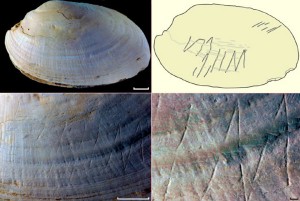500,000-Year-Old Homo erectus artwork Discovered
A multinational group of scientists led by Prof Wil Roebroeks of Leiden University in the Netherlands has uncovered the earliest known etching on a fossilized shell from the famous Homo erectus site of Trinil, on the Indonesian island of Java.
While cataloging hundreds of freshwater mussel shells composed at the end of the 19th century by the Dutch anatomist and geologist Eugene Dubois ,the discoverer of Java man, the first known fossil of Homo erectus , on the banks of the Bengawan Solo river in East Java, Prof Roebroeks and his colleagues noticed that one of the specimens was fixed.
Dr Stephen Munro from the Australian National University says “It was a Eureka moment. I could see instantly that they were man-made engravings. There was no other clarification,”
“It’s fantastic that this engraved shell has been exposed in a museum collection where it has been held for more than a hundred years,” said Prof Roebroeks, who is the senior author of the paper published in the journal Nature.
Following the discovery, the scientists worked to start the exact date of the shell, using two different methods to arrive at the final result of between 430,000 and 540,000 years old.
Dr Munro says “This is the first time we have found proof for Homo erectus behaving this way. It rewrites human record.
The Homo erectus engraving resembles the previously oldest-known engravings, which are connected with either anatomically modern Homo sapiens or Neanderthals from around 100,000 years ago.
“Until this innovation, it was assumed that comparable engravings were only made by Homo sapiens in Africa, starting about 100,000 years ago,” said Dr José Joordens of Leiden University, a team member and the lead author of the paper.
The early date and the location of the discovery on Java discount the option that the engraving could have been the work of Neanderthals or modern humans.
Dr Munro says“It puts these large bivalve shells and the tools used to score them, into the hands of Homo erectus, and will change the way we think about this early human species,”.
“The accuracy with which these early humans worked indicates great dexterity and detailed knowledge of mollusk anatomy,” said team member Dr Frank Wesselingh of the Naturalis Biodiversity Center in Leiden, the Netherlands.
It is unclear whether the model was planned as art or served some practical purpose.Prof Roebroeks says.“At the moment we have no clue about the meaning or idea of this engraving,”
“The scientists also found that Homo erectus opened the shells by drilling a hole through the shell with a shark’s tooth, accurately at the point where the muscle is attached. Injurious muscles this way causes the valves of the shell to open, so that the contents can be eaten.
Dr Munro says “It’s proof that Homo erectus exploited these aquatic food resources, and fits with other proof that they probably foraged in and around water,”
